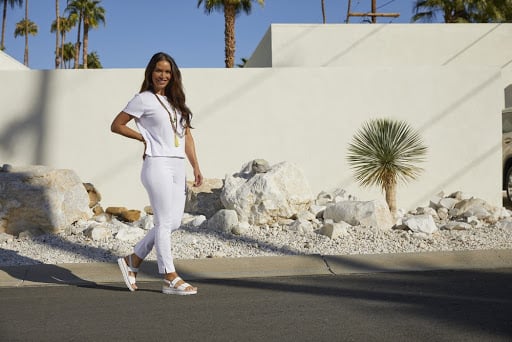
Slides vs Flip Flops: Sandal Comparison
With spring on its way, you may find yourself dreaming of tossing your boots in storage and enjoying a lighter set of spring and summer walking sandals.
There are several different options for spring and summer shoes, but when the weather warms up, the real contest begins: slides vs flip flops.
Whether you’re anticipating some time at the beach, looking for trendy summer dress shoes, or just wanting to air out those toes, we’ve got your sandal info. When it comes to picking the perfect pair of beach shoes, here’s everything you need to know when comparing women’s slide sandals and flip flops.
Sandal History 101
Before we start contrasting these two sandal types—and yes, both of them fall under the category of “sandal”—it’s useful to understand the long past we share with flip flops and slides.
Flip Flops: Walk Like an Egyptian
The flip flop is one of the world’s oldest shoes. Egyptian murals from 4,000 B.C.E. depict variations of flip-flop-type footwear. There’s even a 2,500-year-old flip flop on display in the British Museum.1 When you think about it, it’s no wonder our ancestors wore them. Flip flops were affordable and easy to construct. They could also be made of anything from wood to leather.
Fast-forward to the years after World War II—American soldiers started to bring home souvenirs from Japan. One such souvenir was the zori, a Japanese sandal made from straw that closely resembles what we now know as the flip flop. These sandals exploded in popularity in the 50s, and American manufacturers began making them with a rubber sole.
Nowadays, flip flops are one of the best-selling shoe varieties on the market. Everything from beachside souvenir stands to chic high fashion boutique shops boast endless colors and styles of flip flops.
Slides: From the Shower to the Spotlight
Similar to flip flops, slides have been around for a long time. It’s hard to pinpoint exactly when humans started wearing slide-like footwear, but archeologists in the American Southwest believe they’ve found pairs from more than 8,000 years ago.2
In terms of modern-day fashion, slides entered the scene when artisan Italian shoemakers started crafting them after World War II ended (noticing a trend here?).3 Slides became popular in the US during the 60s, but it wasn’t until the 70s that they really caught on. Legend has it that a German soccer team asked Adidas for a shower shoe, and the black-and-white banded athletic slides are what they came up with.
While the slides may have been built with changing rooms in mind, these summer sandals can now be seen at the beach, on the streets, and even on the runway. Never let anyone tell you that slides can’t be high fashion!

Core Differences
Now that you’ve completed our Introduction to Sandals class, you’re probably noticing more similarities than differences between the two shoes. Both styles are thousands of years old, both gained popularity after the Second World War, and both are still worn across the globe.
However, there are several significant differences between slides and flip flops. Let’s talk about the three main distinctions.
#1 The Strap
One of the most noticeable ways that flip flops and slides differ is the strap. While the strap serves the same function for both styles (to keep the shoe on the foot while walking), the strap placement and shape vary between slides and flip flops.
- On a flip flop, the strap is Y-shaped. Near the front of a typical flip flop, the strap is anchored to the sandal through a hole that goes all the way through to the sole. This part of the strap sits between the big toe and second toe. From there, the strap splits in two, diverging to the left and right to connect to the sides, usually near the arch of the foot. Flip flop straps vary in thickness and are often made of rubber, plastic, fabric, or leather.
- On slides, the strap does not go between the toes. Instead, the foot is held to the rest of the shoe by one or more bands. These bands cross over the foot from one side to the other, forming a sort of “belt.” The width of the strap varies from slide to slide, but they are generally made of firmer materials, especially when they have Velcro or a buckle for size adjustments.
#2 The Insole
When it comes to the insole—the base of the sandal on which your foot rests—flip flops differ from slides in a few ways.
- Width and Shape – Flip flops tend to imitate the shape of the foot, whereas slides are often a bit wider, especially a recovery slide. This additional width is especially visible near the toes.
- Height and Wedge – There’s also the matter of the wedge. Without generalizing too much, the average slide also has more of a wedge than the average flip flop. A wedge elevates the heel at the back of the sandal to provide more support. While you may come across the occasional supportive flip flop equipped with a wedge, it’s more common to see a wedge on a slide.
#3 The Look
Ultimately, there are so many variations of flip flops and slides out there that it can be hard to pick out the differences. When it comes to things like width, material, and so on, there are many flip flops with the characteristics of a slide and vice versa.
One thing that will always be different is the look of each sandal.
- Silhouette – Because slides are usually wider, they may stand out a bit more, giving you a more “chunky” silhouette. Flip flops can be more minimalist, and therefore more discrete.
- Band Style – A slide’s wider strap typically comes with more real estate, so you’ll often see logos, colors, and prints on the top of a slide. Once again, flip flops are usually subtler and more understated.
Slide Sandals vs Flip Flops: Pros and Cons
Though slides and flip flops are both sandals, they come with their own unique sets of benefits and drawbacks. To help you decide which option is best for you, we’ve listed out some key factors of each footwear choice.
Flip Flops
First, some of the benefits of flip flops:
- Simplicity – Flip flops are lightweight, breathable, and casual—perfect if you need to throw something on quickly. Simple colors help you mix and match with any outfit. Bonus? There’s no buckle or tie to adjust whenever you want to throw on your flip flops. Just slip them on and go!
- Grip – Thanks to the strap that goes between the toes, flip flops grip our feet better than many other sandals. As long as you choose a flip flop with good support, you can wear it without worrying about losing a shoe.
- Waterproof – The vast majority of flip flops are waterproof, making them the ultimate beachwear.
Here are some concerns to keep in mind when shopping for flip flops:
- Discomfort Between the Toes – If you wear flip flops for several hours, you may start to notice some discomfort where the strap rubs or pushes against your foot. This issue can often be fixed by wearing the correct size (yes, flip flop sizes vs shoe size might be different) and by choosing flip flops made of more comfortable materials.
- Foot Pain – Flip flops sometimes get a bad rap due to the way their extended use can cause or aggravate foot injuries. That’s why it’s essential to choose a flip flop with arch and heel support. – Flip flops sometimes get a bad rap due to the way their extended use can cause or aggravate foot injuries. That’s why it’s essential to choose a flip flop with arch and heel support.
Slides
And now, let’s look at the best parts of slide ownership:
- Fashionable – Slides are often considered a more fashionable sandal option. Since these styles are in vogue, there’s a wide array of designs to choose from. Slides are also more acceptable in non-beach environments than flip flops.
- Adjustable – Many slides have adjustable straps, allowing for a customized fit.
- Extra Width – With more space for your toes, slides can be a very comfortable choice, especially if you have a wider foot.
Below are some of the downsides of slides:
- They Can Fall Off – Without a strap at the back or between the toes, a slide sandal can literally slide off during any activity other than walking. Be mindful of this if a game of beach soccer breaks out!
- They Take Up More Space – If you’re packing a carry-on for a beach vacation, slides may not be the best choice. Their wider silhouette will take up more of that valuable packing space than other sandals.
Supportive Sandals
Whether you’re looking for chic slides to wear to summer work meetings or adorable flip flops to complete your beach vacation, always look for a comfortable, supportive sandal, that provides plenty of shock absorption regardless of which style you prefer. With stability, arch support, and cushioning built into all of Vionic’s flip flops and slides, the hardest choice is which style to try first.
Sources:
- Kathryn Cain. “The Timeline: Flip-flops”. Independent. www.independent.co.uk/life-style/fashion/features/timeline-flip-flops-2039012.html
- Desiree Stimpert. “Shoe Glossary: Slide”. Liveabout. www.liveabout.com/what-are-shoe-slides-and-slide-sandals-2987860
- Andrea Cheng. “The History of Pool Slides”. CR Fashion Book. www.crfashionbook.com/fashion/a22655925/history-of-pool-slides-fashion/


Leave a Reply